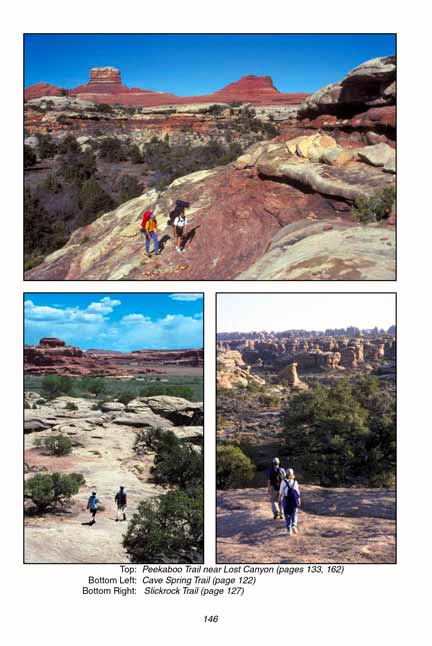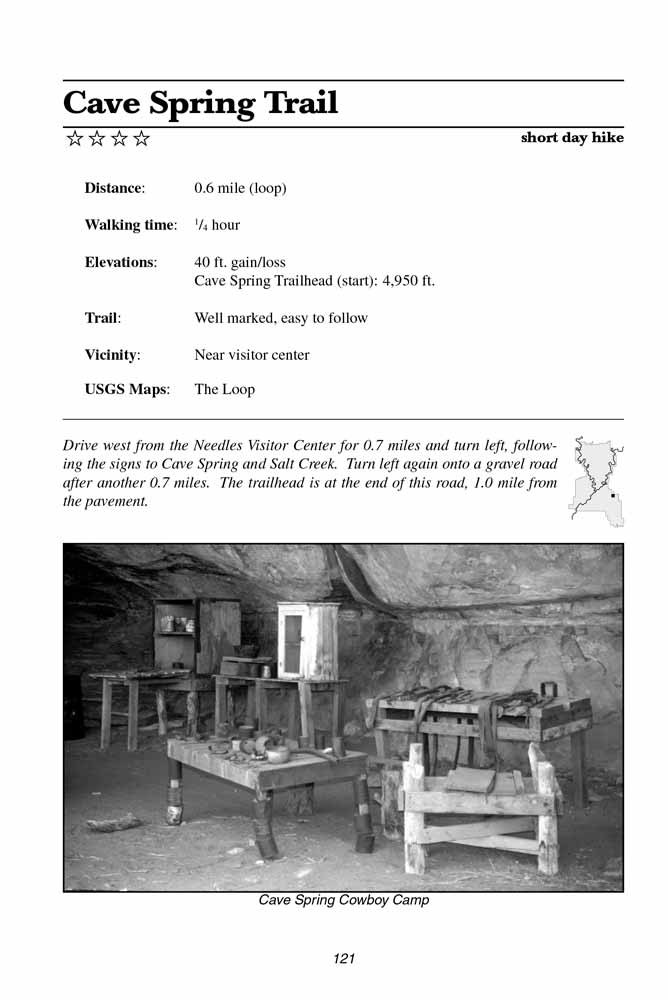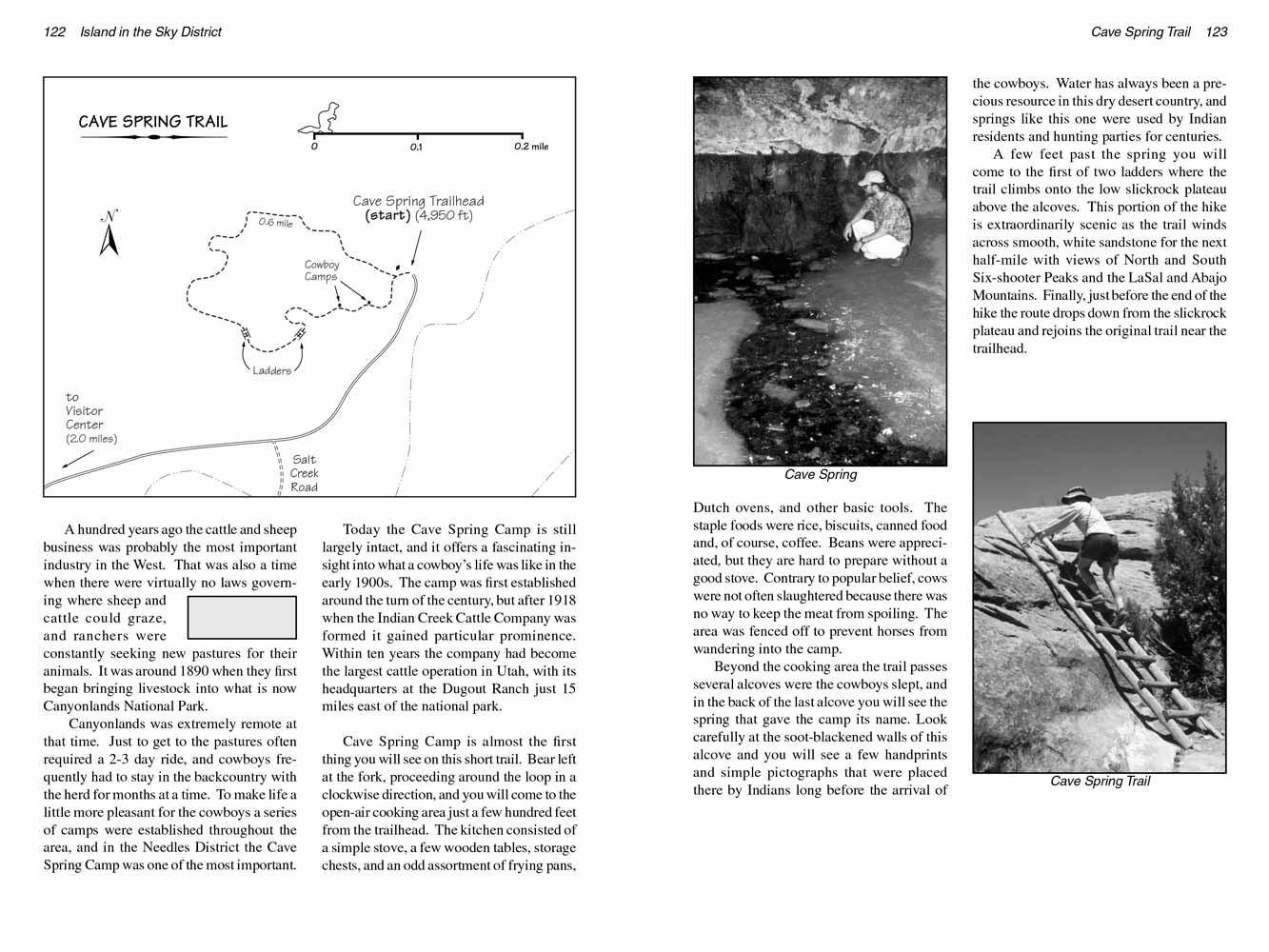Cave Spring Trail
excerpted from our book
Canyonlands National Park
Favorite Jeep Roads & Hiking Trails
pages 121-123
|
Buy book directly from the author!
Canyonlands National Park
Favorite Jeep Roads & Hiking Trails
- has access info for 75 trailheads
- 56 detailed trail maps
- 241 photographs
- loads of driving and hiking tips
|
regularly $14.95
now on sale for only
$11.95
click here
for book orders
|



 A hundred years ago the cattle and sheep business was probably the most important industry in the West.
That was also a time when there were virtually no laws governing where sheep and cattle could graze, and ranchers were constantly seeking new pastures for their animals.
It was around 1890 when they first began bringing livestock into what is now Canyonlands National Park.
A hundred years ago the cattle and sheep business was probably the most important industry in the West.
That was also a time when there were virtually no laws governing where sheep and cattle could graze, and ranchers were constantly seeking new pastures for their animals.
It was around 1890 when they first began bringing livestock into what is now Canyonlands National Park.
Canyonlands was extremely remote at that time. Just to get to the pastures often required a 2-3 day ride, and cowboys frequently had to stay in the backcountry with the herd for months at a time.
To make life a little more pleasant for the cowboys a series of camps were established throughout the area, and in the Needles District the Cave Spring
Cowboy Camp was one of the most important.
Today the Cave Spring Cowboy Camp is still largely intact, and it offers a fascinating insight into what a cowboy’s life was like in the early 1900s.
The camp was first established around the turn of the century, but after 1918 when the Indian Creek Cattle Company was formed it gained particular prominence.
Within ten years the company had become the largest cattle operation in Utah, with its headquarters at the Dugout Ranch just 15 miles east of the national park.
The Cave Spring Cowboy Camp is almost the first thing you will see on this short trail.
Bear left at the fork, proceeding around the loop in a clockwise direction, and you will come to the open-air cooking area just a few hundred feet from the trailhead.
The kitchen consisted of a simple stove, a few wooden tables, storage chests, and an odd assortment of frying pans, Dutch ovens, and other basic tools.
The staple foods were rice, biscuits, canned food and, of course, coffee. Beans were appreciated, but they are hard to prepare without a good stove.
Contrary to popular belief, cows were not often slaughtered because there was no way to keep the meat from spoiling. The area was fenced off to prevent horses from wandering into the camp.
 Beyond the cooking area the trail passes several alcoves were the cowboys slept, and in the back of the last alcove you will see the cave spring that gave the camp its name.
Look carefully at the soot-blackened walls of this alcove and you will see a few handprints and simple pictographs that were placed there by Indians long before the arrival of the cowboys.
Water has always been a precious resource in this dry desert country, and cave springs like this one were used by Indian residents and hunting parties for centuries.
Beyond the cooking area the trail passes several alcoves were the cowboys slept, and in the back of the last alcove you will see the cave spring that gave the camp its name.
Look carefully at the soot-blackened walls of this alcove and you will see a few handprints and simple pictographs that were placed there by Indians long before the arrival of the cowboys.
Water has always been a precious resource in this dry desert country, and cave springs like this one were used by Indian residents and hunting parties for centuries.
A few feet past the spring you will come to the first of two ladders where the trail climbs onto the low slickrock plateau above the alcoves.
This portion of the hike is extraordinarily scenic as the trail winds across smooth, white sandstone for the next half-mile with views of North and South Six-shooter Peaks and the LaSal and Abajo Mountains.
Finally, just before the end of the hike, the route drops down from the slickrock plateau and rejoins the original trail near the trailhead.
Note to web developers: You may copy this material onto your site, but in return please include a link to my home page
www.utahtrails.com. Thank you, David Day (utahdavidday at gmail.com)
Click here to see more trails in
Canyonlands National Park
© Rincon Publishing Company, all rights reserved
|



 A hundred years ago the cattle and sheep business was probably the most important industry in the West.
That was also a time when there were virtually no laws governing where sheep and cattle could graze, and ranchers were constantly seeking new pastures for their animals.
It was around 1890 when they first began bringing livestock into what is now Canyonlands National Park.
A hundred years ago the cattle and sheep business was probably the most important industry in the West.
That was also a time when there were virtually no laws governing where sheep and cattle could graze, and ranchers were constantly seeking new pastures for their animals.
It was around 1890 when they first began bringing livestock into what is now Canyonlands National Park.
 Beyond the cooking area the trail passes several alcoves were the cowboys slept, and in the back of the last alcove you will see the cave spring that gave the camp its name.
Look carefully at the soot-blackened walls of this alcove and you will see a few handprints and simple pictographs that were placed there by Indians long before the arrival of the cowboys.
Water has always been a precious resource in this dry desert country, and cave springs like this one were used by Indian residents and hunting parties for centuries.
Beyond the cooking area the trail passes several alcoves were the cowboys slept, and in the back of the last alcove you will see the cave spring that gave the camp its name.
Look carefully at the soot-blackened walls of this alcove and you will see a few handprints and simple pictographs that were placed there by Indians long before the arrival of the cowboys.
Water has always been a precious resource in this dry desert country, and cave springs like this one were used by Indian residents and hunting parties for centuries.